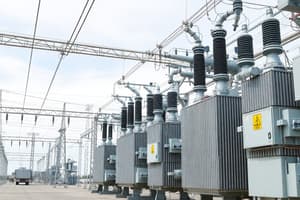Podcast
Questions and Answers
Which of the following advancements in electricity distribution improves efficiency?
Which of the following advancements in electricity distribution improves efficiency?
- Extension cords
- Old transformers
- Incandescent bulbs
- Smart grids (correct)
Resistance measures the voltage in an electrical circuit.
Resistance measures the voltage in an electrical circuit.
False (B)
What is the formula that represents Ohm's Law?
What is the formula that represents Ohm's Law?
V = I x R
Electric power is measured in ______.
Electric power is measured in ______.
Match the following aspects of electricity with their definitions:
Match the following aspects of electricity with their definitions:
Flashcards are hidden until you start studying
Study Notes
Electricity Distribution Efficiency
- Smart grid technology enhances efficiency by optimizing electricity distribution and managing peak loads.
Common Applications of Electricity
- Electricity powers homes, industries, transportation systems, and communication devices.
Factors Influencing Electricity Costs in Ireland
- Fuel prices, weather conditions, demand fluctuations, and regulatory changes can all impact electricity costs.
Non-Influencing Factor for Electricity Cost
- The color of the powerlines does not affect electricity pricing.
Resistance in Electrical Circuits
- Resistance quantifies the opposition that a material presents to the flow of electric current, measured in ohms.
Ohm's Law Formula
- Ohm's Law is represented by the formula: V = I × R, where V is voltage, I is current, and R is resistance.
Unit of Electric Power
- Electric power is measured in watts (W).
AC vs. DC Power
- Alternating Current (AC) changes direction periodically, while Direct Current (DC) flows in a single direction.
Frequency of AC Power
- The frequency of AC power, measured in hertz (Hz), indicates how many cycles of the current occur in one second.
Relationship between Voltage, Current, and Resistance
- Voltage (V) is the potential difference, current (I) is the flow of electrical charge, and resistance (R) impedes that flow. The relationship is outlined in Ohm's Law.
Power Calculation Formula
- Power in a circuit can be calculated using the formula: P = V × I, where P is power, V is voltage, and I is current.
Instrument for Measuring Current Flow
- An ammeter is used to measure the current flow in a circuit.
Measuring Voltage Across a Component
- Voltage across a component can be measured using a voltmeter connected in parallel with the component.
Multi-functional Test Instrument
- A multimeter is capable of measuring current, voltage, and resistance.
Efficiency Calculation Formula
- Efficiency of an electric component is calculated using the formula: Efficiency = (Output Power / Input Power) × 100%.
Studying That Suits You
Use AI to generate personalized quizzes and flashcards to suit your learning preferences.




